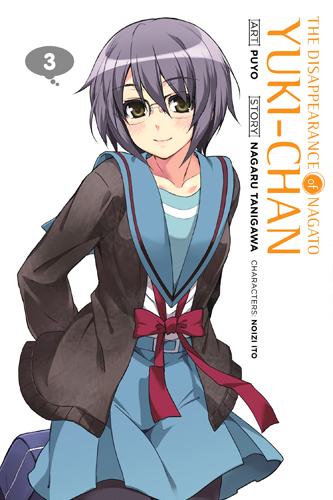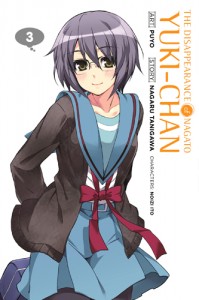By Nagaru Tanigawa and Puyo. Released in Japan as “Nagato Yuki-chan no Shoushitsu” by Kadokawa Shoten, serialization ongoing in the magazine Young Ace. Released in North America by Yen Press.
A Quick Guide to writing manga AUs for the otaku fan, by Sean Gaffney.
I’m assisted today by Puyo, author of the Disappearance of Nagato Yuki-chan, a spinoff of the Disappearance movie filtered through the sensibilities of Puyo’s Haruhi-chan gag manga. With that in mind, let’s examine a volume of this series closely, keeping an eye out for handy tips.
The first thing to learn is that you have to know your audience. In this case, the audience are fans of the Haruhi franchise who read Kadokawa Shoten’s Young Ace magazine. They’re a built-in fanbase, and know the source material inside and out. This has its uses. You don’t have to delve so hard into character introductions, as everyone reading it knows who you’re writing about. And it means that your character interaction can be subtler. Take a look at page 27, which features Mikuru. Her dialogue, “I’m not very assertive, though, so I appreciate it when people can push me into doing things” is a redemptive reading for the original series’ Haruhi. This Mikuru is free to admit that she’s not simply being bullied and assaulted by a girl she can’t say no to, but is grateful for the assertiveness training.
In fact, this is another of the main bonuses to franchises like these, especially ones based on a light novel with a first-person narrator. Due to the viewpoint, the reader’s observations and biases are linked with the main character, as you rarely see scenes outside his purview. Even a straight manga adaptation, such as Haruhi’s, is forced by its source material into this narrow path. But in Nagato Yuki, the viewpoint is third person, which means we have the opportunity to see people in perspectives other than Kyon’s. This is particularly helpful in regards to Haruhi and Ryoko (or, as I like to call them, OTP), Both these characters change when they’re around each other. Ryoko, normally forced to be the perfect oneesama around Kyon and Yuki, lets out her childish immaturity near Haruhi. Likewise, the genki Haruhi is forced into the straight man role around Ryoko, and shows a genuine concern for her. Both characters benefit immensely from this.
The key in writing these sorts of AUs is to deviate from canon an acceptable amount, but not too much. In this case, the material is benefited by the movie itself, which gave us the shy, emotional Nagato used for this adaptation. Certain other AU adaptations, which I won’t name but rhyme with Bevamgelion, have taken their characters and made them 100% different from the original in almost every way, leading the reader to wonder why they simply didn’t create a new character? (The answer, as I’m sure you all know by now, is MONEY. Use your franchise well and use it wisely.) Nagato Yuki here is considerably different from the canon, to be sure, but the movie helped build a bridge, and there are enough signs of the original (Yuki’s explanations being incomprehensible, her reaching out for the stars) that it works.
Even Kyon, who has been poorly developed so far, gets a bit to do here, as his conversation with Ryoko shows that he seems more aware of Yuki’s affection than his canon counterpart, and is simply taking things slow. (As for Koizumi, well, he gets nothing. The others even acknowledge in the story how useless he is. We’ll be discussing this next month when we talk about the Kyon and Koizumi collection.)
In terms of things NOT to do – get back here, Puyo, and take your medicine – the artist’s art still needs work. His shading is too simplistic, especially in regards to hair. This means when you have Haruhi, Tsuruya, and Ryoko all standing near each other, they can be difficult to distinguish. I shouldn’t have to identify a person only by their hairband or eyebrows. There’s also quite a bit of fanservice here, but the artist wisely put it all in one eight-page chapter, along with the interstitials. And really, compared to some other Kadokawa titles I’ve seen, this is pretty tame. The readers of this book are the “D’aaaaawww, look at them being adorable!” crowd, they don’t need lots of nipples.
I apologize to the class for the cliffhanger ending, but Puyo assures us there’s a good reason for it, and reassures us that Yuki is not in fact killed by a car. That would make the rest of the series quite short. In the meantime, your homework is to compare and contrast this franchise to Evangelion – whoops, sorry, Bevamgelion – and Alice in the Country of Hearts, paying particular attention to which audience subset each separate spinoff title aims for. We’ll see you back here in May, and we’ll have a lot more to talk about with Yuki then. Dismissed!


Pingback: MangaBlog — Shonen Jump takes a giant leap